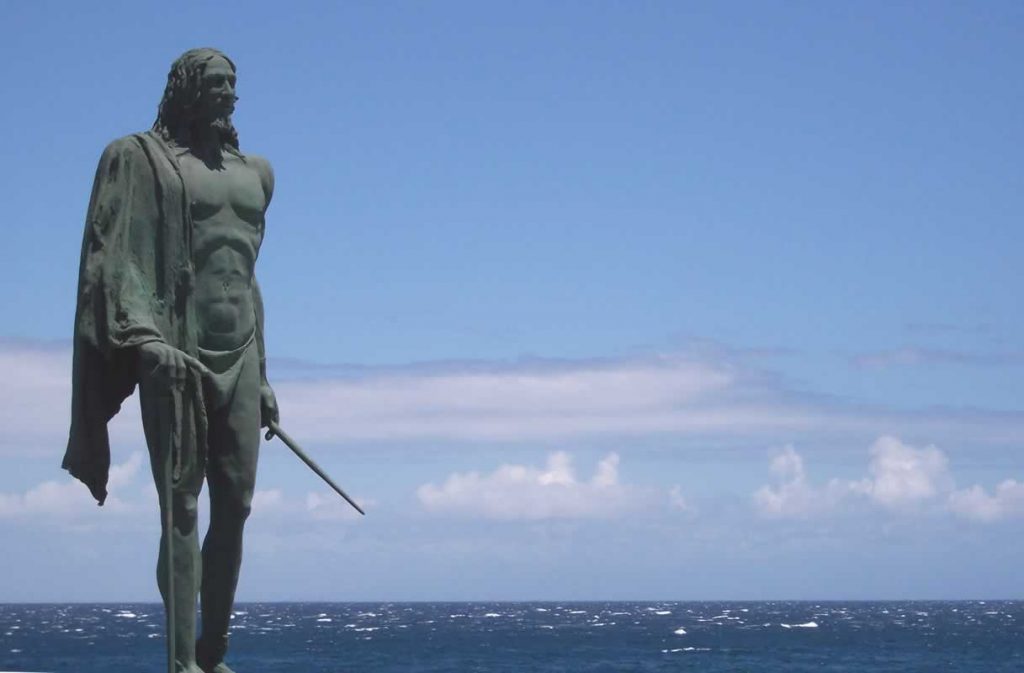During the late 15th century, Spanish sailors encountered a series of islands: Tenerife, La Palma, Gran Canaria, and Gomera–located west of Africa and now known as the Canary Islands. Since these lands had the adequate conditions for growing sugar and producing wine, products in high demand in Europe, it was not long before plantations and trading posts were build by the Spanish.1

Apart from having profitable resources, the islands also became an important stopping point in the trans-Atlantic trade routes, since the islands lay between the New and the Old Worlds. What is often overlooked, however, is that long before the Europeans set foot on these islands and established trading posts, a group of indigenous people lived on these remote lands; the Guanche, a group of blonde-haired and blue-eyed people, resided on the islands.2
When the Spanish arrived, they were surprised to find that the Guanche people lived in stone age conditions: taking shelter in caves and huts, wearing little clothing made of reeds, and using stones and sticks as weapons. Despite their primitive lifestyle, the Guanche lived in a hierarchical society and were ruled by a group of elders and “menceys” (kings). The rest of the tribe consisted of farmers who raised goats, pigs, and sheep in the hills, and with their basic techniques, planted seeds in the valleys. They built pyramids in an east-west alignment indicating that they worshiped the rising and the setting of the sun; they also made pottery and mummified their dead.3

Once the Guanche were discovered by the Europeans, they suffered the same fate that most tribes did in this era; they were forced into slavery on sugar plantations. As a result of harsh labor and of the devastation to the Guanche population, their culture barely survived.4 But if we could rewind time back to the days before the Spanish encountered the Canary Islands, we would still be left with some important questions: How did the Guanche arrive in the Canary Islands? From where do they originate?
There are several theories regarding the mysterious arrival of the Guanche in the Canary Islands, but none are certain. The most mentioned and supported hypothesis is that the Guanche tribe were descendants of the Moroccan Berber tribesmen. Researchers have discovered that the Guanche had similar homes, burial practices, and rock carvings as the tribes that once resided in North Africa. The story goes that there was a group of Berbers in the fifth century who rebelled against the Romans, and were thus exiled to the Canary Islands. It is argued that the Guanche originated from this region because their physical traits, specifically the blond hair and blue eyes, are often also seen among the Berbers, and that Guanche’s whistle-like language “tamazight insular” has its origins in the Berber’s language.5

On the other hand, historian Caroline Spence argues that the Guanche do not originate from Morocco in North Africa; instead, they come from Egypt. According to this theory, the tribe used papyrus reeds to make the boats they used to travel to the islands, and because this material rots rapidly, it would explain why no boat remains were ever discovered.6 There are several other cultural characteristics that tie the Guanche to the Egyptians. For example, both civilizations worshiped celestial bodies and had similar practices when dealing with their dead. The Guanche mummified the bodies of the elite with similar techniques to that of the Egyptians, like binding the nails, packing the body with stuffing, and painting the hair of the mummy with henna. Also, several small step pyramids were found in the Canary Islands that are similar to the Egyptians.’ However, it is unknown whether it was the Guanche who built these pyramids to hold celebrations on or whether they were built after the islands were discovered by Spanish farmers who were clearing stones.7

Due to their physical characteristics, it is also contended that the Guanche are direct descendants from Europeans who–in 3000 B.C.E.–sailed from what is now the French Coast and the Iberian Peninsula, and were left stranded on these Atlantic islands. There are countless other less credible theories that explain the arrival of the Guanche, including one that the Vikings–who were skilled sailors–transported people to the islands, who then somehow lost their knowledge of seamanship.8 Some even argue that the Guanche are the remains of the sunken city of Atlantis, who over time evolved a new language and style of living.


Undeniably, the arrival of the Guanche on the Canary Islands remains an enigma. It is not known when, how, or in what numbers they arrived; it is only known that there is a link between them and other civilizations. No theory is definitive and it is debatable whether the Guanche even interacted with other civilizations prior to 1494, when Alonso Fernandez de Lugo conquered the Canary Islands enslaving and murdering its indigenous people. Despite this, the Guanche culture is not entirely extinct, because on the island of Gomera, the Guanche’s whistle talk survives as a reminder of the baffling existence of the Guanche.9.
- Jerry H. Bentley, Herbert F. Ziegler and Heather E. Streets-Salter, Traditions and Encounters: A Brief Global History Vol 2 (New York: MacGraw-Hill Education, 2016), 352, Kindle Edition ↵
- In Science and Its Times, 2001, s.v. “Jean de Bethencourt and Gadifer de La Salle Colonize the Canary Islands for Spain,” by Judson Knight. ↵
- Arthur Kemp, March of the Titans: The Complete History of the White Race Vol 1 (Ostara Publications, 2008), Chapter 6 ↵
- George Glas, Barker Webb, Sabin Berthollet, and Miss Haigh, “Some Account of the Island of Teneriffe and Its Inhabitants, at the Time of the Spanish Conquest; Taken from the “History of the Discovery and Conquest of the Canary Islands, by George Glas; and the “Histoire Naturelle Des Iles Canaries,” by Barker Webb and Sabin Berthollet,” Transactions of the Ethnological Society of London, no. 7 (1869): 107-114. ↵
- Mario Garcia Conde and Hector Roldan Delgado, “The Last of the Atlanteans,” Child’s Nervous System Vol. 26, no. 9 (2010): 1131. ↵
- Caroline Spence, “Mystery of the Guanche,” Geographical (Campion Interactive Publishing) Vol 72, no. 8 (2000): 43. ↵
- Caroline Spence, “Mystery of the Guanche,” Geographical (Campion Interactive Publishing) Vol 72, no. 8 (2000): 42. ↵
- Steenie Harvey, “Isles of Eternal Spring,” World & I 17, no. 4 (2002): 178. ↵
- “Conquest of the Canary Islands Explained.” Everything Explained Today. Accessed March 2, 2017 ↵



52 comments
Mario Sosa
It is very intriguing to read about the many possibilities of where the Guanche originated from. I do not know how people could possibly associate the Guanche with Atlantis. Perhaps if the Europeans had attempted to peacefully communicate with the Guanche people rather than enslave and dominate them, then maybe we would know more about their origin. Well researched article, nicely done!
Priscilla Reyes
Well researched, Ana! I love that you provided multiple theories and explained why each of them could stand for the Guanche’s. Personally, I lean towards the first theory mentioned, although the others have true to them. I liked that you included their language, its origin, and its current state in the Canary Islands. Your title is perfect along with the pictures included!
Aaron Jaramillo
This is a very interesting article on the Guanche people. We briefly touched on the Guanche people in my civilization class so its satisfying to read an article about them. Its terrible to read that the Spanish didn’t treat them well. The Guanche were nearly wiped out because the Spanish disrupted their way of living. Very well done article Ana!
Faisal Alqarni
Hi Anna , very interesting story about the Guanche, I had never heard of such a people before this, it is sad that the Spanish almost destroyed them by disrupting their way of life and making hem work in plantations. I really like the different theories you present, after piecing some together myself I can argue that the Guanche were descendants of Egyptians given practices such as building of pyramid’s and mummification of their dead. Also their basic way of life can only mean they did not have the know- how of travelling far and therefore could not have come from Europe but only Africa.
Teresa Valdez
The mystery of the Guanche people has been made very captivating by this article. Each theory is laid out as alternatives to others in a way that I cannot decide which I believe to be the most plausible. This region is so interesting in both its location and culture. The traditions and features of the Guanche people seem so odd in comparison to the surrounding areas. The article is very well organized and well researched. Well done!
Mario De Leon
Very Interesting read. I have never heard of the Guanche people and I am glad you decided to tell their story. It was nice how you gave background information on the Canary Islands because it gave a clear picture as to why the Europeans wanted to establish trading post there. The fact that the Guanche arrival on the Canary Islands is a mystery is fascinating and I wonder if we will every have a definite answer as to how they arrived.
Sergio Cervantes
Great article! It is interesting to read about the countless theories you listed that explain how the Guanche people arrived on these islands. I cannot believe it still remains a mystery to this day! The fact that the Guanche share numerous similarities with other tribes could maybe support the claim that they come from multiple tribes. It was odd reading about the physical characteristics of the people since they are much different from those of the tribes of the Americas. It is nice to hear that their language is still remembered and spoken in a small part of the world.
Zaraly Frasquillo
This is amazing dude! I enjoyed every last word of your article. I think it is fascinating how the Guanche have so many similarities to different cultures. It does make the reader wonder “where did they come from?” But isnt that the question to everything? Like, where did the Aztecs come from? Or where did the Egyptians come from? I think the mystery as to where a civilization or people came from will never really have a concrete answer, but it is great to have an idea, you know? But, hands down this was a great article!
Jennifer Pogue
Awesome article! I truly enjoyed reading it and I love your writing style. Like most article topics, I never learned about this in high school history, but I wish I would have. It is very sad that they were conquered just because they were not as advanced as the Europeans. I think it is very strange how they are still not sure how the Guanche people got to the Canary Islands, or how they were still living in the stone age. Overall amazing article and I look forward to reading your future articles!
Christopher Repka
Ana, this was a really cool article. I knew that Canary Islanders had help build San Fernando Cathedral in Main Plaza here in San Antonio, but I didn’t know anything else about them prior to reading this article. Your article was well research and contained some well selected images. The information itself was fascinating as well. Thank you for an interesting read.